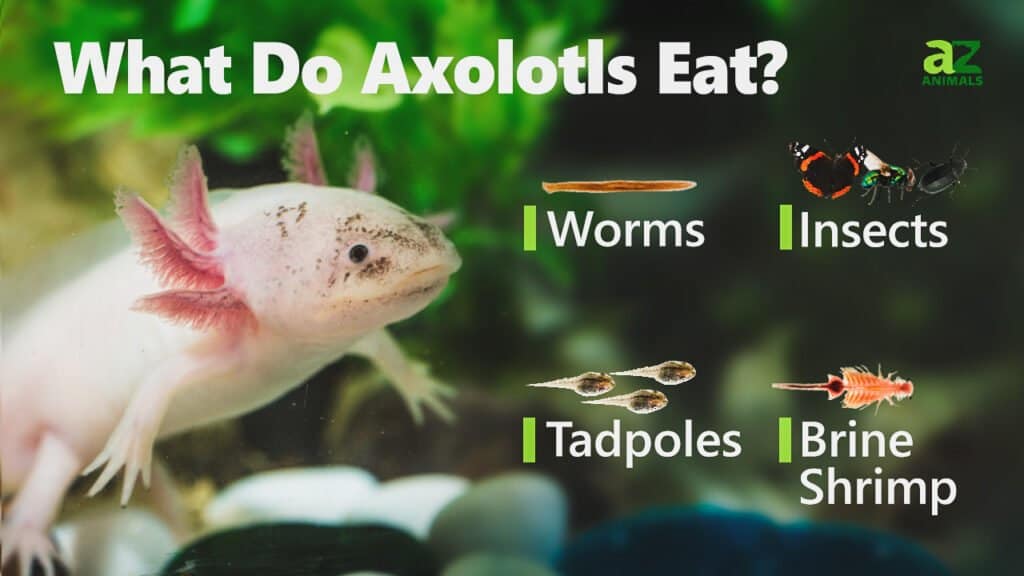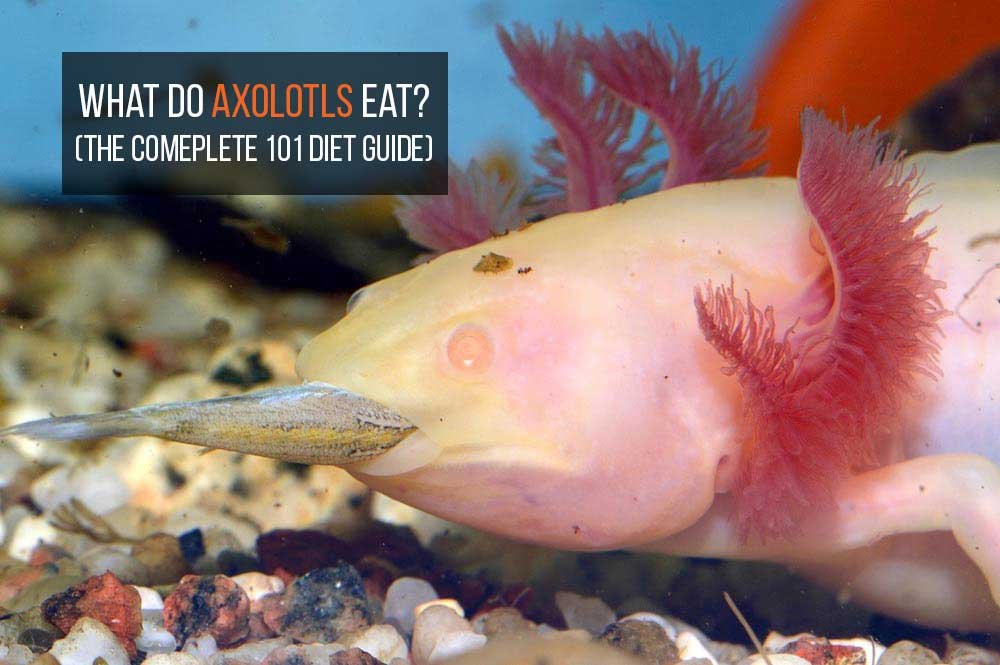To feed an axolotl, provide a varied diet of live or frozen food, such as brine shrimp, bloodworms, and daphnia. Axolotls enjoy a diverse diet of live or frozen food, including brine shrimp, bloodworms, and daphnia.
Feeding them a variety of nutritious options is essential for their health and well-being. As aquatic creatures, these unique amphibians have specific dietary requirements to thrive in captivity. By offering a selection of live or frozen foods, axolotls can easily capture their prey with their suction-like mouths.
We will explore the necessary steps to properly feed your axolotl, ensuring they receive a balanced diet and stay in excellent condition. So, let’s dive into the world of axolotl nutrition and discover the best ways to nourish these fascinating creatures.

Credit: a-z-animals.com
Understanding The Dietary Needs Of Axolotl
Understanding the dietary needs of axolotls is crucial for their overall health and well-being. Axolotls are carnivorous creatures, so it is important to provide them with a balanced diet that meets their nutritional requirements. A key factor to consider when feeding axolotls is the importance of including a variety of foods in their diet.
This ensures that they receive all the necessary nutrients and vitamins they need to thrive. Some common food options for axolotls include live or frozen bloodworms, brine shrimp, and small pieces of fish. It is essential to avoid overfeeding axolotls, as this can lead to obesity and other health problems.
By following these guidelines and providing a nutritious diet, you can help ensure the health and longevity of your axolotl.
Recommended Foods For Axolotl
Axolotls, being carnivorous creatures, thrive on a diet that primarily consists of live foods. Brine shrimp and daphnia are excellent choices as they provide essential nutrients. Bloodworms and blackworms also make suitable options, meeting the axolotls’ dietary requirements. Furthermore, commercially available axolotl pellets are a convenient alternative.
These pellets are specifically formulated with the necessary nutrients for axolotls’ growth and development. While live foods are vital, it is beneficial to supplement the axolotl diet with vegetables and fruits occasionally. Chopped pieces of cucumber, zucchini, and small portions of fruits, such as banana, can be added to their meals.
It is important to note that axolotls have different feeding preferences, so it may be necessary to experiment to find the best combination of foods to keep them healthy and satisfied. Regular observation and adjusting their diet accordingly will ensure the well-being of these fascinating amphibians.
Feeding Techniques For Axolotls
Feeding axolotls requires proper portion control to ensure their health and well-being. Finding the right frequency of feeding is crucial for both juvenile and adult axolotls. For young axolotls, feeding should be more frequent, while adult axolotls can be fed less often.
Hand-feeding is a useful technique to monitor their food intake and establish a bond with your pet. Target training can also be implemented to encourage axolotls to associate feeding time with specific cues or actions. By following these feeding strategies, you can ensure that your axolotl receives the right amount of food and stays happy and healthy.
Addressing Common Feeding Issues
Axolotls are unique pets that require specific care, especially when it comes to feeding them. Overfeeding can lead to detrimental consequences, such as obesity and poor water conditions. It is important to recognize signs of malnutrition, such as weight loss and reduced appetite, to ensure their health.
Dealing with picky eaters can be challenging, but it is crucial to offer a varied diet and experiment with different types of food. When feeding multiple axolotls in the same tank, it is essential to monitor each individual’s intake and ensure they all receive an adequate amount.
By following these tips, you can ensure that your axolotls are well-nourished and thriving.
Feeding Schedule And Maintenance
Feeding an axolotl requires establishing a regular schedule. By monitoring their feeding behavior, you can adjust the schedule accordingly. Additionally, regular tank cleaning and maintenance of water quality is essential for a healthy appetite. Axolotls are known to have a voracious appetite, so it’s important to feed them appropriate amounts of food.
Overfeeding can lead to health issues, so it’s best to give them small, frequent meals. Their diet mainly consists of small live or frozen foods, such as bloodworms, brine shrimp, and daphnia. It’s important to provide a varied diet to ensure they receive all the necessary nutrients.
Remember to remove any uneaten food from the tank to maintain water quality. Following these guidelines will help keep your axolotl healthy and well-fed.
Frequently Asked Questions For How To Feed Axolotl
How Often Should You Feed An Axolotl?
Axolotls should be fed once a day, with a diet consisting of small, high-quality pellets or live foods such as blackworms or bloodworms. It’s important to feed them only what they can consume in 5-10 minutes to prevent overeating and maintain their health.
What Is The Size Of The Food That An Axolotl Can Eat?
Axolotls can eat food that is approximately the size of their head or slightly smaller. It’s best to offer them bite-sized portions to prevent choking hazards and to ensure that they can easily consume the food without any difficulty.
Can Axolotls Eat Fruits Or Vegetables?
No, axolotls are carnivorous and should not be fed fruits or vegetables. Their diet should consist of protein-rich foods such as pellets or live foods like worms. Feeding them the wrong type of food can lead to digestion issues or other health problems.
How Do You Know If An Axolotl Is Full?
One way to tell if an axolotl is full is by observing its behavior during feeding. If it stops actively searching for food, becomes disinterested, or ignores the food, it is likely full. Overfeeding can lead to obesity and other health issues, so it’s important to feed them appropriately.
Can Axolotls Eat Feeder Fish?
Axolotls can eat feeder fish, but it’s not recommended. Feeder fish can carry diseases or parasites that can be harmful to the axolotl. Additionally, feeder fish may be too large or aggressive, causing stress or injuries to the axolotl. It’s best to stick to a diet of pellets or live foods specifically formulated for axolotls.
Should Axolotls Be Fed At Night?
Axolotls are most active during the night, so it’s ideal to feed them in the evening or when the lights are dimmed. This mimics their natural feeding behavior and allows them to eat comfortably. However, if feeding during the day works better for you, it is fine as long as they are receiving proper nutrition.
Conclusion
To keep your axolotl healthy and happy, it’s crucial to provide them with a nutritious and varied diet. By offering a mix of live foods like worms, insects, and small fish, alongside high-quality pellets and frozen options, you can ensure your axolotl gets all the essential nutrients it needs.
Remember to feed them appropriately, considering their size and appetite, to avoid overfeeding or underfeeding. Keeping their environment clean and monitoring their eating habits is also important. Regularly checking for signs of malnutrition or obesity will help you make necessary adjustments to their diet.
With a proper feeding regimen, you can promote your axolotl’s growth, enhance their immune system, and support their overall well-being. By following these tips, you can ensure your axolotl lives a healthy and thriving life.
